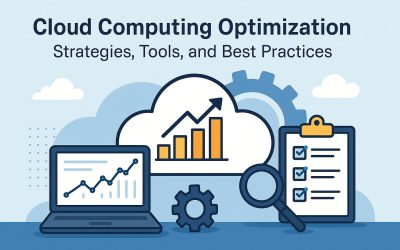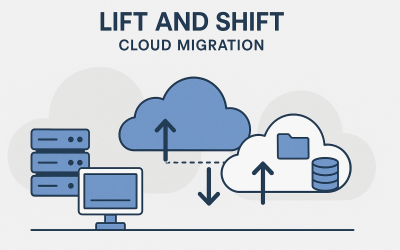In the realm of cloud computing scalability, the primary difference between vertical and horizontal scaling lies in their approach to handling increased workload. Vertical scaling involves enhancing the capabilities of a single server by adding more resources, such as CPU or RAM, while horizontal scaling focuses on expanding capacity by adding more servers or instances to distribute the workload.
This article will delve into the nuances of these scaling methods, exploring their advantages, considerations, and suitability for different scenarios in cloud computing environments. From simplicity and cost-effectiveness to scalability limits and redundancy, we’ll cover everything you need to know to make informed decisions about scaling strategies for your applications.

What Is Vertical Scaling in Cloud Computing?
Vertical scaling, or scaling up, increases a single server’s capability by upgrading its hardware components. This approach is suitable for predictable workloads and can be cost-effective for smaller applications. However, it has limits, as a single server can only be scaled so far, and it introduces a single point of failure risk.
In vertical scaling, the focus is on making an individual server more powerful to accommodate growing demands. This can be achieved by replacing existing hardware with higher-capacity components or adding supplementary hardware to the server. For example, if an application experiences increased traffic or data processing requirements, vertical scaling would involve upgrading the server’s CPU to a faster model or increasing the amount of RAM available to handle larger datasets more efficiently.
What Is Horizontal Scaling in Cloud Computing?
Horizontal scaling, or scaling out, adds more servers to distribute the workload, improving scalability and availability. This method is ideal for applications with fluctuating demands but requires effective load balancing and infrastructure management to maintain consistent performance.
In horizontal scaling, new servers or instances are added to the existing infrastructure to accommodate growing demands. This can be achieved by deploying additional servers in a cluster, each capable of handling a portion of the overall workload. For example, if a web application experiences increased traffic, horizontal scaling would involve adding more web servers to share the incoming requests and improve responsiveness.
Importance of Scalability In Cloud
Organizations of all sizes should consider the advantages of cloud computing, particularly focusing on the benefits of scalability:
- Simplicity: Adjusting capacity is a straightforward process for IT administrators, requiring just a few clicks. This eliminates the need for dealing with physical hardware, saving time and effort.
- Efficiency: Cloud-based upgrades or downgrades are swift, taking days instead of weeks. Businesses can swiftly configure their infrastructure based on evolving business needs, ensuring agility and responsiveness.
- Cost-Effectiveness: Cloud providers follow a pay-as-you-go model, charging organizations only for the resources they use. This eliminates the need to invest in outdated or redundant equipment, leading to cost savings and improved financial management.
- Reliability: Scalable cloud architectures guarantee high performance, capable of handling sudden surges or drops in demand. This reliability ensures consistent service delivery, bolstering customer satisfaction and operational efficiency.
Vertical Scaling Vs Horizontal Scaling – Key Differences
| Aspect | Vertical Scaling | Horizontal Scaling |
| Definition | Increases capacity of a single server by adding resources (CPU, RAM, etc.) | Adds more servers or instances to distribute workload |
| Flexibility | Limited scalability; capped by hardware limitations | Virtually limitless scalability; can add servers as needed |
| Complexity | Relatively simple implementation; minimal changes to existing infrastructure | Requires robust architecture and coordination for distributed system management |
| Scalability | Suitable for predictable workloads or smaller-scale applications | Ideal for unpredictable or fluctuating workloads, large-scale applications |
| Cost-Efficiency | Cost-effective for smaller applications or predictable workloads | More cost-efficient at scale, as it uses commodity hardware |
| Redundancy | May result in single point of failure if upgraded server fails | Offers redundancy; failure of one server does not impact entire system |
| Maintenance | Easier to manage and monitor, as it involves a single instance | Requires effective load balancing mechanisms and monitoring for multiple instances |
| Scalability Limits | Limited scalability beyond hardware constraints | Offers virtually unlimited scalability, adding servers as needed |
| Application Suitability | Suitable for applications with low to moderate scalability needs | Ideal for applications with high scalability demands or variable workloads |
Pros Of Vertical Scaling
Here are the pros of vertical scaling in detail:
- Simplicity and Ease of Implementation: Vertical scaling is straightforward to implement as it involves upgrading the resources of a single server. IT administrators can add more CPU power, RAM, or storage capacity with relative ease, requiring minimal changes to the existing infrastructure. This simplicity makes vertical scaling an attractive option for organizations looking for quick capacity upgrades without significant architectural changes.
- Cost-Effective for Predictable Workloads: Vertical scaling can be cost-effective for applications with predictable workloads or modest scalability needs. Since it involves enhancing the capabilities of a single server, organizations can optimize resource usage and avoid over-provisioning, leading to efficient cost management. This cost-effectiveness is particularly beneficial for smaller-scale applications or businesses with budget constraints.
- Maintained Single Instance Management: With vertical scaling, applications run on a single instance, simplifying management and monitoring tasks. IT teams can focus on optimizing the performance of a single server without the complexities of managing a distributed system. This streamlined management approach can reduce overhead and ensure efficient resource utilization.
- Quick Capacity Upgrades: Vertical scaling allows for rapid capacity upgrades as needed. IT administrators can increase the resources of a server with just a few clicks, avoiding lengthy procurement processes or hardware setup time. This agility in capacity management enables organizations to respond promptly to increased demand without downtime or service interruptions.
- Resource Utilization: Vertical scaling optimizes resource utilization by leveraging the full capabilities of a server. By adding more CPU, RAM, or storage, organizations can efficiently use available resources without wasting capacity. This efficient resource utilization promotes cost savings and maximizes the return on investment in hardware upgrades.
- Suitable for Specific Workloads: Vertical scaling is well-suited for applications with specific workload characteristics, such as those requiring high computational power or memory-intensive tasks. It allows organizations to tailor server configurations to meet the exact requirements of their applications, ensuring optimal performance and scalability.
Cons of Vertical Scaling
Here are the cons of vertical scaling in detail:
- Limited Scalability: One significant drawback of vertical scaling is its limited scalability compared to horizontal scaling. Vertical scaling involves upgrading the resources of a single server, and there is a cap on how much a server can be scaled vertically. As the workload continues to grow, hardware limitations may eventually restrict further scalability, leading to performance bottlenecks or capacity constraints.
- Single Point of Failure: Vertical scaling can result in a single point of failure. If the upgraded server experiences hardware failures or malfunctions, it can impact the entire application or service running on that server. This lack of redundancy increases the risk of downtime and service interruptions, especially if there are no failover mechanisms or backup resources in place.
- Cost Inefficiency at Scale: While vertical scaling can be cost-effective for smaller-scale applications or predictable workloads, it may become cost-inefficient at scale. As organizations continue to upgrade server components to handle increased demands, the cost of hardware upgrades, maintenance, and licensing fees can escalate significantly. This cost inefficiency is particularly notable when compared to the more cost-effective scalability options offered by horizontal scaling and cloud-native architectures.
- Resource Underutilization: Vertical scaling can lead to resource underutilization. Upgrading a single server’s components may result in over-provisioning resources that are not fully utilized, especially during periods of lower demand. This inefficiency can lead to wasted capacity and increased operational costs without proportional performance improvements.
- Complexity of Maintenance: While vertical scaling simplifies initial implementation and management of a single server, it can introduce complexities in long-term maintenance. Managing a highly scaled server with multiple upgraded components requires careful monitoring, performance tuning, and troubleshooting. IT teams may face challenges in optimizing resource usage, identifying performance bottlenecks, and ensuring seamless integration with other systems or services.
Pros Of Horizontal Scaling In Cloud Computing
Here are the pros of horizontal scaling in detail:
- Unlimited Scalability: Horizontal scaling offers virtually unlimited scalability compared to vertical scaling. By adding more servers or instances to distribute the workload, organizations can scale their infrastructure seamlessly to accommodate growing demands. This scalability flexibility ensures that applications can handle increasing workloads without encountering performance bottlenecks or capacity limitations.
- High Availability and Redundancy: Horizontal scaling provides built-in redundancy and high availability. With multiple servers or instances handling the workload, there is no single point of failure. If one server experiences hardware failures or issues, the remaining servers can continue to serve requests, ensuring uninterrupted service delivery and minimizing downtime risks.
- Improved Performance and Load Balancing: Horizontal scaling improves performance by distributing the workload evenly across multiple servers or instances. Effective load balancing mechanisms ensure that incoming requests are distributed optimally, preventing any single server from being overwhelmed. This even distribution of workload enhances system responsiveness, reduces latency, and improves overall user experience.
- Cost-Effectiveness at Scale: Horizontal scaling can be more cost-effective, especially at scale. Organizations can use commodity hardware and scale their infrastructure incrementally based on actual demand. This pay-as-you-go approach eliminates the need for upfront investments in expensive hardware upgrades, leading to cost savings and optimized resource utilization.
- Flexibility and Adaptability: Horizontal scaling offers flexibility and adaptability to changing workload patterns. Organizations can add or remove servers dynamically based on fluctuating demand, seasonal variations, or business growth. This agility allows businesses to scale their infrastructure in real-time, responding promptly to evolving market conditions without delays or disruptions.
- Global Reach and Geographic Distribution: Horizontal scaling enables global reach and geographic distribution of services. By deploying servers in multiple geographic regions, organizations can reduce latency, improve performance for users worldwide, and comply with data residency requirements. This global scalability supports international expansion strategies and enhances market reach.
Cons of Horizontal Scaling In Cloud Computing
Here are the cons of horizontal scaling in detail:
- Complexity of Management: Horizontal scaling can introduce complexities in managing a distributed system with multiple servers or instances. IT teams need to implement robust infrastructure management tools, load balancing mechanisms, and monitoring solutions to ensure optimal performance, resource utilization, and fault tolerance. This complexity in management may require additional expertise and resources, leading to higher operational overheads.
- Cost of Infrastructure: While horizontal scaling can be cost-effective at scale, it may initially require investments in infrastructure setup and configuration. Deploying and maintaining multiple servers or instances, along with networking infrastructure and load balancers, can incur upfront costs. Organizations need to consider the total cost of ownership, including hardware, software, licensing, and ongoing maintenance, when adopting horizontal scaling solutions.
- Network Overhead and Latency: Horizontal scaling can introduce network overhead and latency issues, especially in distributed architectures spanning multiple locations or data centers. Data transfer between servers or instances, synchronization of databases, and communication between components can contribute to increased network traffic and latency. IT teams must optimize network configurations and implement efficient data transfer protocols to mitigate these challenges.
- Data Consistency and Synchronization: Maintaining data consistency and synchronization across multiple servers or instances can be challenging in horizontal scaling environments. Updates, transactions, and data replication processes must be carefully managed to ensure data integrity and avoid conflicts or inconsistencies. Implementing robust data synchronization mechanisms, distributed databases, or caching solutions is essential to address these concerns.
- Security and Compliance: Horizontal scaling introduces security and compliance challenges related to data protection, access control, and regulatory requirements. Securing a distributed system involves implementing robust authentication mechanisms, encryption protocols, and audit trails to safeguard sensitive data. Ensuring compliance with industry standards, privacy regulations, and data residency laws across multiple locations adds complexity to security management.
- Resource Fragmentation: Horizontal scaling can lead to resource fragmentation, where resources are distributed unevenly across servers or instances. Inefficient resource allocation may result in underutilized or overutilized servers, affecting overall system performance and resource utilization. IT teams must implement effective resource monitoring, load balancing, and capacity planning strategies to mitigate resource fragmentation issues.
How To Choose Between Vertical vs Horizontal Scaling?
When faced with the decision between vertical and horizontal scaling for your infrastructure, several crucial factors come into play. Each scaling approach in cloud computing has its strengths and considerations, making it essential to assess your specific needs and objectives. Here are four key areas to consider when choosing between vertical and horizontal scaling:
- Hardware and Software Considerations:
Hardware and software considerations encompass evaluating the capabilities of your existing infrastructure and the scalability options provided by your software stack. Assess the scalability limits of your hardware components, such as CPU, RAM, and storage capacity, to determine if vertical scaling is feasible. Additionally, consider if your software architecture supports horizontal scaling through distributed systems, microservices, or containerization. Understanding your hardware and software capabilities is fundamental to selecting the most suitable scaling approach. - Load Balancing and Redundancy:
Load balancing and redundancy are critical aspects of scaling to ensure optimal performance and fault tolerance. In horizontal scaling, implement effective load balancing mechanisms to evenly distribute incoming traffic across multiple servers or instances. This prevents any single server from becoming overwhelmed and maintains consistent performance. Additionally, leverage redundancy strategies, such as data replication and failover mechanisms, to ensure high availability and resilience against hardware failures or disruptions. - Monitoring and Scaling Triggers:
Monitoring and scaling triggers involve setting up robust monitoring tools and defining criteria for scaling decisions. Implement monitoring solutions to track key performance metrics, resource utilization, and workload patterns in real-time. Identify scaling triggers based on predefined thresholds, such as CPU usage, memory utilization, or incoming traffic volume. Establish automated scaling policies to trigger vertical or horizontal scaling actions when resource demands exceed predefined thresholds, ensuring proactive scalability and efficient resource management. - Disaster Recovery Planning:
Disaster recovery planning is crucial for maintaining business continuity and minimizing downtime in the event of hardware failures, system crashes, or natural disasters. Develop comprehensive disaster recovery plans that include backup strategies, data replication, failover configurations, and recovery procedures. Consider how vertical or horizontal scaling impacts disaster recovery capabilities. Horizontal scaling inherently offers redundancy and fault tolerance, enhancing disaster recovery readiness, while vertical scaling may require additional measures to ensure resilience and continuity.
Evaluate hardware and software considerations carefully. Implement effective load balancing and redundancy strategies. Set up monitoring and scaling triggers. Develop robust disaster recovery plans. These steps will help you decide whether vertical or horizontal scaling best suits your infrastructure.
Each area plays a crucial role in optimizing performance, resilience, scalability, and business continuity in dynamic and evolving IT environments.
Looking for cloud consulting services provider? Saisatwik Technologies can help. Contact us today!
FAQs About Horizontal Scaling vs Vertical Scaling in Cloud
Is horizontal scaling cheaper than vertical?
Horizontal scaling can be more cost-effective than vertical scaling, especially at scale. With horizontal scaling, you can use commodity hardware and add servers incrementally based on demand, optimizing resource utilization and reducing upfront costs. Vertical scaling may require expensive upgrades to hardware components, leading to higher initial investments.
What are the disadvantages of vertical scaling?
The disadvantages of vertical scaling include:
1. Limited scalability beyond hardware constraints.
2. Potential single points of failure if the upgraded server experiences issues.
3. Cost inefficiency at scale due to expensive hardware upgrades.
4. Resource underutilization as a single server may not fully utilize added resources.
5. Complexity of managing highly scaled servers with multiple upgraded components.
What is the limit of vertical scaling?
The limit of vertical scaling is determined by hardware constraints such as CPU, RAM, and storage capacity. As the workload and resource demands increase, there comes a point where further vertical scaling becomes impractical or cost-prohibitive. This scalability limit varies depending on the hardware specifications and workload characteristics.
Does AWS offer vertical scaling?
Yes, AWS (Amazon Web Services) offers vertical scaling options through services like Amazon EC2 (Elastic Compute Cloud). With EC2, you can vertically scale instances by resizing them to higher CPU, RAM, or storage configurations. AWS also provides auto-scaling features for horizontal scaling, allowing you to dynamically adjust the number of instances based on demand.
Why is vertical scaling less common?
Vertical scaling is less common compared to horizontal scaling for several reasons:
Limited scalability beyond hardware constraints.
Cost inefficiency at scale due to expensive hardware upgrades.
Potential single points of failure if the upgraded server experiences issues.
Difficulty in managing highly scaled servers with multiple upgraded components.
Preference for cloud-native architectures and distributed systems supporting horizontal scaling for flexibility, redundancy, and cost-effectiveness.



0 Comments